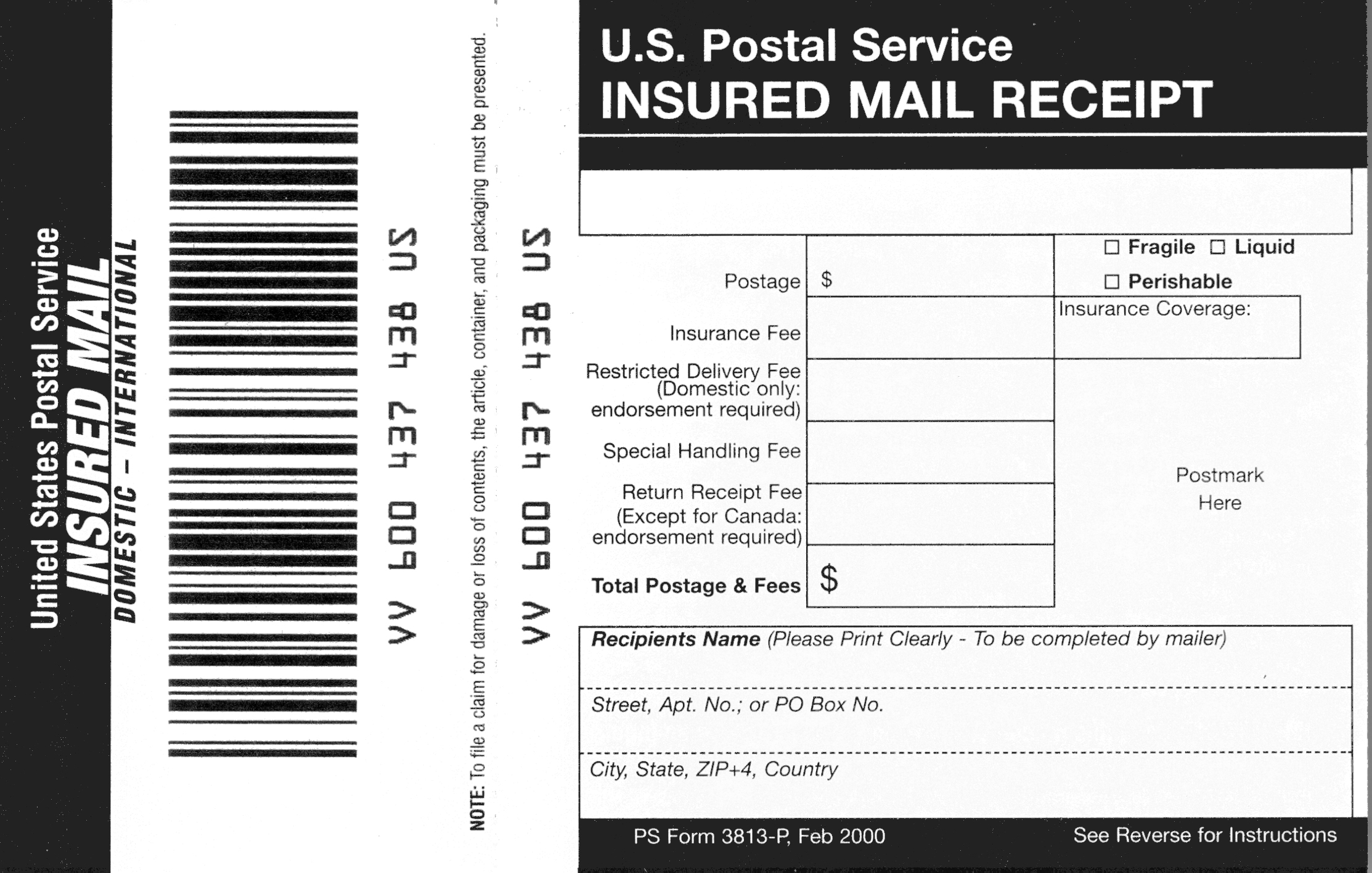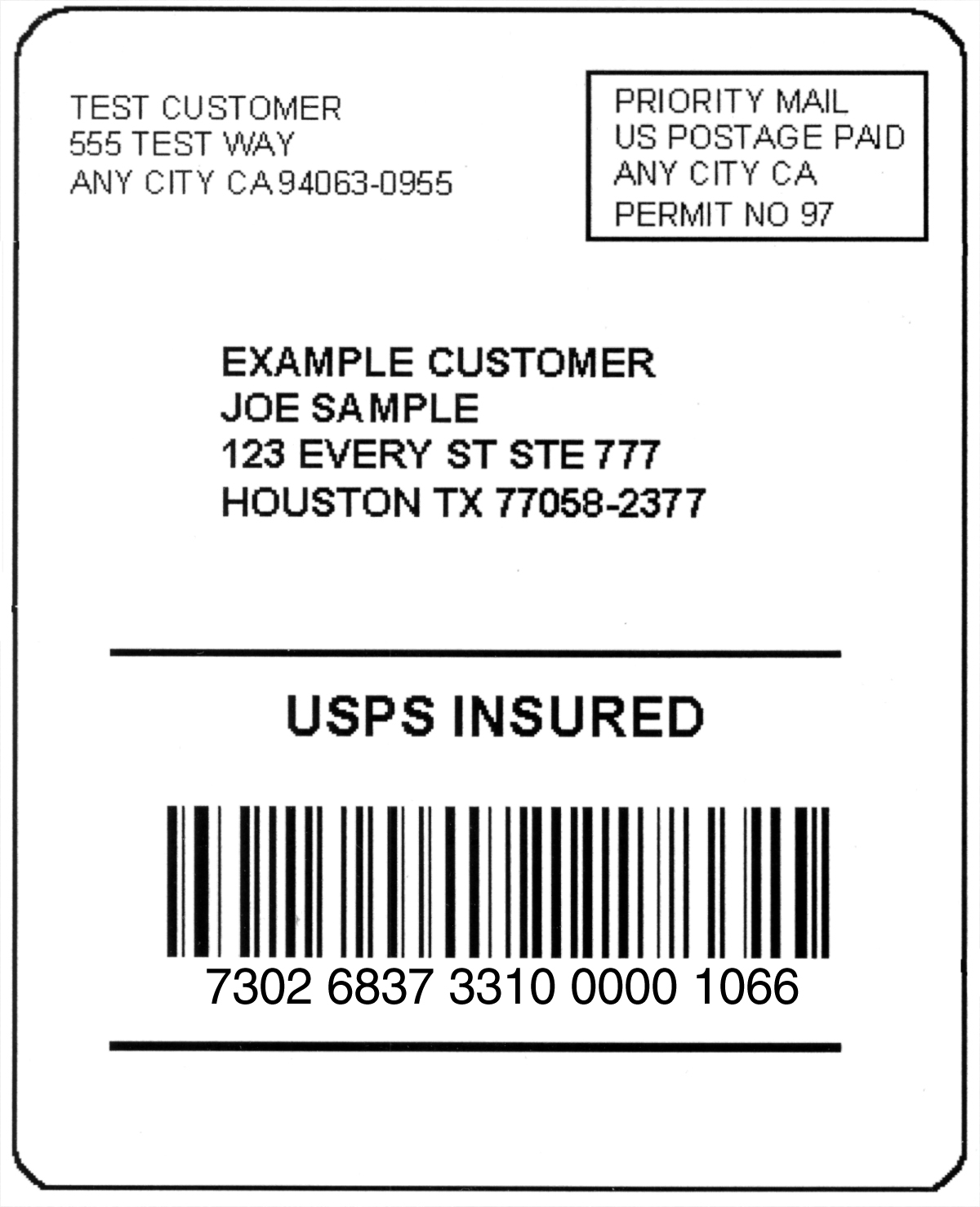 |
 |
S900 Special Postal Services
S910 Security and Accountability
S913 Insured Mail
Summary
S913 describes insured mail, what matter is eligible and ineligible for insurance, and the procedures to follow for mailing insured mail. It also covers the requirements to mail at the bulk insured service rates.
1.0 Basic Information
1.1Description
Retail insured mail provides up to $5,000 indemnity coverage for a lost, rifled, or damaged article, subject to the standards for the service and payment of the applicable fee. A bulk insurance discount is available for insured articles entered by authorized mailers who meet the criteria in 3.0. No record of insured mail is kept at the office of mailing. Insured mail service provides the sender with a mailing receipt. For mail insured for more than $50, a delivery record is maintained by the Postal Service. Insured mail is dispatched and handled in transit as ordinary mail.
1.2Eligible Matter
The following types of mail matter may be insured:
a. Package Services.
b. First-Class Mail (including Priority Mail), if it contains matter that may be mailed as Package Services.
c. Standard Mail pieces subject to the residual shape surcharge (bulk insurance only).
d. Official government mail endorsed “Postage and Fees Paid.”
1.3Ineligible Matter
The following types of mail may not be insured:
a. Parcels containing matter offered for sale, addressed to prospective purchasers who have not ordered or authorized their sending. If such matter is mailed, payment is not made for loss, rifling, or damage.
b. Nonmailable matter.
c. Articles so fragile that they cannot be carried safely in the mail regardless of packaging.
d. Articles not adequately prepared to withstand normal handling in the mail. As a rule, any mailable package should be insurable.
e. Mail not bearing the complete names and addresses of the sender and addressee.
f. Standard Mail pieces that are not subject to the residual shape surcharge.
g. Matter mailed at First-Class Mail rates (including Priority Mail) that consists of items described in E110 as required to be mailed at the First-Class rates.
1.4Fee and Postage
The applicable insurance fee must be prepaid in addition to the postage, except on official mail sent under applicable provisions. The mailer guarantees to pay return and forwarding postage, unless the mailer writes instructions on the wrapper or envelope not to forward or return the mail.
1.5Additional Services
Insuring an item for more than $50 allows customers to then purchase restricted delivery service or a return receipt. The following additional services may be combined with insurance if the applicable standards for the services are met and the additional service fees are paid:
a. Delivery Confirmation.
b. Parcel airlift service (PAL).
c. Return receipt for merchandise (for items insured for up to $50).
d. Signature Confirmation.
e. Special handling.
1.6Delivery Record
Mailers may request a delivery record after mailing under S915.
2.0 Mailing
2.1Where to Mail
A mailer must mail insured mail at a post office, branch, or station or give the mail to a rural carrier. Such mail may be placed in, but not on, a rural mailbox. Such mail must not be placed in a post office maildrop or in or on a street letterbox. A mailer may leave the mail in a rural box with a note showing the requested amount of insurance, if stamps are affixed for postage and fees or money for postage and fees is left in the box. The USPS is not liable for any article or money left in a rural box until the carrier receipts the article. A mailer at a nonpersonnel rural unit must meet the rural carrier at the unit for insurance service.
2.2USPS Inquiries
USPS employees are required to ask whether the package presented for insurance contains fragile, perishable, or flammable matter.
2.3Markings and Use of Form 3813-P
The treatment of parcels is determined by the insurance amount:
a. Insured for $50 or less: Each parcel must be stamped on the address side with an elliptical insured marking as shown in Exhibit 2.3. This marking must be placed above the delivery address and to the right of the return address.
b. Insured for more than $50: Each parcel must have barcoded Form 3813-P (see Exhibit 2.3) affixed above the delivery address and to the right of the return address. Form 3813-P must not be used for parcels insured for $50 or less.
c. All insured parcels, regardless of insurance amount, must be postmarked unless a postage meter stamp or permit imprint is used to pay postage.
Exhibit 2.3Insurance Marking and Form
3813-P


2.4Privately Printed Form 3813-P
If authorized, a mailer may use a privately printed Form 3813-P for domestic mail only. The privately printed form must be nearly identical in design and color to the USPS form with a barcode and human readable numbers that meet the USPS specifications in Publication 109. A minimum of three preproduction samples must be submitted to the business mail entry manager serving the mailer’s location for review by the mailpiece design analyst. Once approved, the mailer must print sample labels with barcodes to be certified under the technical requirements in Publication 109.
2.5Integrated Barcodes
There are other options available for mailers who print their own labels:
a. An integrated barcode may be used by Confirmation Services electronic option mailers who wish to combine insurance with Delivery Confirmation or insurance with Signature Confirmation into a single barcode on the shipping label to eliminate multiple labels and barcodes on packages. Additional information on the integrated barcode solution can be found in Publication 91, Confirmation Services Technical Guide.
b. Mailers have a third option for privately printed labels with insurance (see Exhibit 2.5). The privately printed label must meet the specifications described in Publication 91. Applicable certification procedures must be followed, also as specified in Publication 91.
Exhibit 2.5Mailer-Printed Label with Integrated
Barcode

2.6Prohibited Markings
Private insurance endorsements or markings may not appear on the address side of mail but may appear elsewhere, if they do not resemble official postal endorsements and are not confused with postal endorsements.
2.7Receipt
For each insured parcel mailed, the mailer receives the appropriate receipt:
a. Form 3813 when the insurance value is $50 or less.
b. Form 3813-P when the insurance value is more than $50.
2.8USPS Records
The USPS keeps no mailing records for insured parcels. The mailer must write the addressee’s name and address on the receipt and keep it. The mailer must show the receipt when making a claim for loss or filing an inquiry.
2.9Firm Sheet
If three or more insured articles are presented for mailing at one time, the mailer may use Form 3877 (firm sheet) or privately printed firm mailing bills. Privately printed or computer-generated firm sheets that contain the same information as Form 3877 may be approved by the local postmaster. The mailer may omit columns from Form 3877 that are not applicable to insured mail. The mailer must present the books with the articles to be mailed at a post office. The sheets become the mailer’s receipts. All entries made on firm sheets must be made by typewriter, ink, or ballpoint pen. Alterations must be initialed by the mailer and accepting employee. All unused portions of the addressee column must be obliterated with a diagonal line.
3.0 Additional Requirements—Bulk Insurance
3.1Eligibility
To mail at the bulk insured service rates, mailers must obtain an authorization under 3.2 and must meet the following criteria:
a. Enter mailings of insured articles under an approved manifest mailing system agreement.
b. Mail a minimum of 10,000 insured articles annually. To meet the minimum volume requirement, mailers may total all insured articles mailed at multiple locations.
c. Provide a hard copy of Form 3877 or facsimile and a copy of Form 3877 on a disk or other electronic medium.
d. Effective at a future date, provide a soft (electronic) copy of Form 3877 in a new, approved format.
3.2Authorization
Mailers must apply for authorization to mail at the bulk insured service rates through their local postmaster or designee by completing the customer portion of the Bulk Insured Service (BIS) verification form. The postmaster or designee will verify on this form that the mailer meets the requirements in 3.1. If the mailer does not meet the requirements, the application will be denied. If the mailer meets the requirements in 3.1, the postmaster or designee will certify on the Bulk Insured Service (BIS) verification form that the mailer qualifies and forward the form to the manager of Claims Processing at the St. Louis Accounting Service Center (ASC). After reviewing the information, St. Louis will notify the postmaster of their concurrence of the application and provide a range of claim numbers to be used by the mailer for filing claims. The postmaster or designee will then provide the customer with the approval of the application and with information needed to file claims, including the assigned claim numbers. At a future date, electronic filing of indemnity claims will become mandatory. Prior to mandatory electronic claims filing, customers will be provided with the format instructions for the new electronic (soft copy) of Form 3877 and instructions for electronic filing of indemnity claims.
4.0 Delivery
An item insured for $50 or less is delivered as ordinary mail. Delivery of insured mail is subject to D042.
DMM Issue 58 (8-10-03)